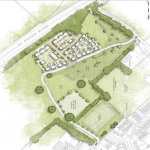As ConserveBridge reported on 29 September 2017, Quinn Estates and Highland Court Group (HICO) presented their plans for the development of Highland Court Farm on Thursday, 28 September at Bridge Village Hall. The plans include the building of a business park, office space, extensive new build of 300 holiday homes, a 150-unit retirement village, a food and drink hub and pitches for Canterbury Rugby Club and Canterbury Football Club. Not only is the land AONB designated, but it is not allocated for development in the recently adopted Canterbury District Local Plan. Quinn and HICO face an uphill struggle to convince local residents, planners and others to give the plans the green light.
The proposal was discussed by councillors at the Bridge Parish Council meeting of Thursday, 12 October. When asked for his own views about the proposed Highland Court development at a meeting of Bridge Parish Council this week, the leader of Canterbury City Council, and North Nailbourne Councillor, Simon Cook, who lives in Bridge, said that he was not convinced by arguments from Quinn and HICO that such an extensive development in an AONB is of “national significance”. ConserveBridge welcomes Mr Cook’s views which, we emphasise, were expressed in a personal capacity and not on behalf of Canterbury City Council.
CPRE has criticised the proposals and urged Quinn and HICO to withdraw them. A response from Kent Downs AONB is awaited with interest. Meanwhile Bridge Parish Council voted to work with adjoining parish councils to see if it is possible to present a united position against the development plans, with six parish councillors voting to oppose the plans, with one abstention.
ConserveBridge is pleased to read from local social media posts that action to oppose the plans is starting to take shape. We wish these efforts every success. We also welcome recent action against the proposed Mountfield development.
The controversy over Mountfield was re-ignited when Mr Justice Dove threw out the case brought by Emily Shirley and Michael Rundell on air quality grounds. The High Court judge decided that the Secretary of State had not erred in refusing to “call in” (in other words, to decide for himself) the planning application, stating that the Secretary of State was entitled to expect Canterbury City Council to lawfully decide the planning application itself by taking into consideration all material considerations, including air quality. ConserveBridge understands that Emily and Michael have applied to the Court of Appeal for permission to appeal Dove’s decision on the grounds that it is wrong in law. A decision on the prospects of an appeal is expected imminently.
Emily has also applied for permission to apply for judicial review of the adoption of the Canterbury District Local Plan, which proposes large scale housing and other unsustainable development with an unlawful policy in respect of air quality and without a compliant strategic environmental assessment. Since January 2010, Canterbury has been in breach of legal air pollution limits on several occasions at key spots in the city. The City Council’s recently adopted local development plan proposes 16,000 new houses on farmland outside the city boundary which, it is estimated, would result in an additional 112,000 daily car journeys. Concerns about pollution in our cathedral city have been expressed by Emily and others, including amenity groups and a leading public health expert. You can find out more about Emily’s campaign challenging the local plan here.
 The result of the Bridge village vote of 25 November on the Cantley proposal has been announced:
The result of the Bridge village vote of 25 November on the Cantley proposal has been announced:



